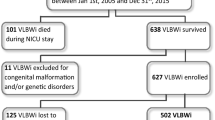Abstract
Objective: To assess the ability of the Clinical Risk Index for Babies (CRIB) to predict long-term neurodevelopmental impairment in very low birth weight (VLBW) infants.¶Design: Single-center cohort study.¶Setting: Tertiary neonatal care hospital and follow-up clinic.¶Patients: Four hundred fifty-five VLBW infants consecutively admitted from 1992 to 1997 inclusive.¶Measurements and results: Calculations of CRIB scores from birth weight, gestational age, the presence of congenital malformations, worst base excess, maximum and minimum appropriate fraction of inspired oxygen (FIO2) during the first 12 h of life was possible in 430 infants. Three hundred eighty-six infants survived until discharge (89 %) and 352 (91 %) were examined at 1 year corrected age using the Griffiths scales of mental development. Major neurodevelopmental impairment (general quotient < 2 standard deviations below average) was observed in 76 infants (22 %). CRIB scores and the individual CRIB components differed significantly between infants with and those without neurodevelopmental impairment. By logistic regression analysis, CRIB scores and minimum FIO2 were independent predictors of death, while CRIB and maximum FIO2 were independently associated with neurodevelopmental impairment. For combined poor outcome (death or impairment), CRIB, minimum and maximum FIO2 were independent predictors. In predicting major neurodevelopmental impairment, the area under the receiver operating characteristic curve for CRIB (0.703 ± 0.035) did not differ significantly from that of birth weight (0.697 ± 0.035) or any other CRIB component.¶Conclusion: While high CRIB scores are associated with major neurodevelopmental impairment, the CRIB score is of limited value for stratification in randomized trials or for adjustments in comparing performance between hospitals with neurodevelopmental impairment as the main outcome measure.
Similar content being viewed by others
Author information
Authors and Affiliations
Additional information
Received: 19 September 1999/Final revision received: 19 July 1999/Accepted: 20 December 1999
Rights and permissions
About this article
Cite this article
Bührer, C., Grimmer, I., Metze, B. et al. The CRIB (Clinical Risk Index for Babies) score and neurodevelopmental impairment at one year corrected age in very low birth weight infants. Intensive Care Med 26, 325–329 (2000). https://doi.org/10.1007/s001340051157
Issue Date:
DOI: https://doi.org/10.1007/s001340051157




